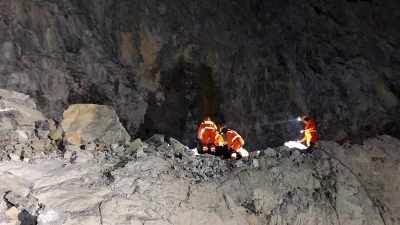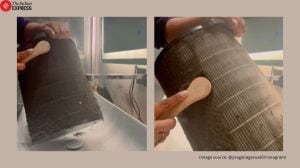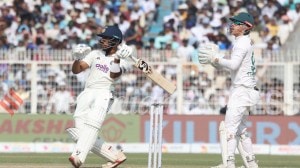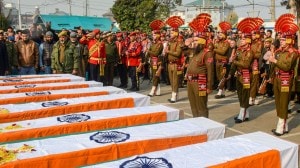India Counts
The Sunday Express follows Census enumerators into the heart of India.
Searching for homes in what was Veerappans terrain
There, the boy tells his teacher,pointing to what looks like an earthen coloured speck in the distance,separated from them by a vast shrub land,a small stream,a rocky hill and,for a stranger,a sense of loneliness. That was their next destination.
They have been traversing this region,these two: Alagumalar,25,the young woman from the plains of Madurai,and her local guide Madhavan,a third standard student of the panchayat school where she teaches.
Thalakkarai,a scattered hamlet in Tamil Nadu,abuts the forest that once formed part of the territory of slain forest brigand Veerappan,which earned it considerable notoriety.
Now,over half-a-decade after he was killed by a Special Task Force,the region on the Karnataka border has drifted back to its former obscurity. Here in the land of the dead brigand,now populated by elephants and other wild animals and the men who took over the space vacated by the legends death,Alagumalar is not scared about her safety but is only worried about the long distance to be covered. To reach Dhottathais house from Veerabhadrans,there is a long distance and longer time. Most huts are beyond visual limits and the pathway is mostly rocky. That is where Madhavan comes into the picture,in locating the household and telling her which stones to step.
But that is only the getting-there part. In the last Census,over 6,000 languages and dialects were recorded in India,PG Stalin,a grade-I statistical investigator with the Census Department,tells us with considerable excitement,while walking behind the enumerator and her guide. She,obviously does not share his enthusiasm.
Sometimes the real difficulty is in understanding what the folks are saying. Most of them speak only Kannada, he says. Time to call the boy wonder,Madhavan.
There are times even he cant be of any help. Like when they encounter those like Puttiyamma and Dhottathai.
Of the 29 queries that form part of the questionnaire,Puttiyamma cannot answer the one on age. She points to her grey hair to indicate her age group: old.
Stalin and his colleagues Ashwin Sukumar and A Mariappan have been travelling in the four districts under his zone to supervise the enumeration work. There is also a team that is videographing the exercise across the state for a documentary that the department commissioned.
Each of them knows this is a massive exercise and it has also given them a sense of perspective about their country,their fellow citizens and about themselves.
They were delightfully surprised to find in a remote hamlet in The Nilgiris,a system where one stone is kept for each deceased person. The size of the stone is determined by the age of the deceased. That means they have a method to document each death,including approximate years the person lived, says Stalin.
But the remoteness is not out of choice. They simply have no option. Transport facilities are so rare and thus expensive that they come out only rarely, said a documentation crew member.
It is already evening,time for Alagumalar to return home from the hill,but her day was not fruitfulshe covered only three houses. Tomorrow,she has to start early; she is going to the other side of the mountain.Gopu Mohan
Counting the living,and the dead too,in Sopore
Whenever Bashir Ahmad Najar comes towards the end of the Census form and asks question 28,most people break into tears. They take a while to compose themselves before dealing with the column that asks them about their children,both living and dead. In Sopore,as in other parts of Kashmir,Census 2011 is not just a count of the living. It is also a count of the dead. Ever since militancy began in the valley,Sopore has been its epicentre.
For the past nine days,Najar,a teacher in the J&Ks Education department,has been calling upon houses at Khankah-e-Moula in old town Sopore.
On Thursday,accompanied by his supervisor Abdul Samad,an engineer in the Public Health engineering department,Najar knocks first at the door of Mohammad Maqbool Dar,a fisherman. Sixty-year-old Dar welcomes them in with a smile and the questions begin. Dar replies promptly,sometimes with the help of his children. But when Najar comes to column 28,Dar stops,his eyes turn moist and he mumbles the name of his son. He was killed four years ago, he says. But dont mention his name in this list please. Dont mention who killed him.
Dar says his son was killed by unidentified gunmen and he is scared to write about it. Overwhelmed,he leaves the room.
Thank God,they have kept this question at the end, says Najar. Most people break down when asked about their dead sons. If this question would have been placed in the first part,it would have really been difficult for us to complete this Census.
But this is not the only question thats proving to be a challenge for Najar. At the house of Imtiyaz Ahmad Kababi at Nowhamam Sopore,his 18-year-old daughter,Shaista Imtiyaz opens the door. Why are you asking for details on my family? she says hesitantly before finally letting them in.
A large number of people tell us that such surveys have been done many times before but nothing has come out of them. It takes us a lot of time to explain them why Census is important and how it is different from the other surveys.
Unlike earlier,separatists in the Valley have not called for a boycott of the Census. Instead,they have asked the people to actively participate in it. BASHAARAT MASOOD
Doing the math in Mewat
Adjust kar lo,masterji. So masterji,Phool Chand Sharma,teacher of English and social studies at the Government Senior Secondary School in Mewat,scratches his ear with his right hand,the pencil in his left hand nervously flitting from one column to the next on the Census form. Sharma,one of the 1,901 enumerators in Mewat district of Haryana,has some serious adjusting to do as he fills up the Census forms in Vijaynagar,a Muslim settlement in Tauru tehsil of the district.
People here are poor and uneducated. They dont know their dates of birth,the names of their children…some dont even know how many children they have, says Ram Lal,an upper division clerk at the Census office in the district headquarters of Nuh. Today,Ram Lal is accompanying Sharma on the enumeration round. Ek aadmi se nahi ho payega. Masterji needs help. We have to make sense of what these people say and fill the Census forms…adjust karna padta hai.
Mewat,a largely rural district in Haryana,has some of the poorest literacy and health figures in India. Tauru,the tehsil headquarters,is about 16 km from Nuh,a half-an-hour winding drive up the Aravalli ranges. The Muslims of Mewat,called the Meos,make up 73 per cent of the districts population. But in the few urban centres like Tauru,they are in a minority,living on the outskirts,in settlements like Vijaynagar,Block 5/2 , the area Sharma has to cover today.
Its well past noon as Sharma and Ram Lal walk into the settlement. Because its Milad-un-Nabi today,well find most of the men at home. On other days,I have to catch them either early in the morning or late at night, says Sharma. Sharma looks at his listits Jalaluddins house first,House No 286.
A cot is spread out and Sharma and the head of the household,Jalaluddin,sit down. A group of children and young men crowd around. Jalaluddin is confused. Kya hai yeh? Janganana ho rahi hai (Its the Census), Sharma says. Jalaluddin continues to look around. Arre,mardam shumari …, hollers Ram Lal. Mardam shumari is Urdu for Census,so Jalaluddin agrees to talk.
From here on,its a battle. When were you born? Jalaluddin smiles,looks at his mother and the old woman nods dismissively. He looks nervous,so Ram Lal takes over. When was he born? Garmi me,sardi mein? The old woman looks annoyed. Nobody asked us all this then,so we don’t know. Age? Jalaluddin bites his lips and smiles. How old is the eldest son? Bees (20), one of the women says. So Sharma does some math: Assuming he was 20 at the time of his marriage and his eldest son is 20,that makes him 40. They finally settle for 44. Wife’s age? 19. Sharma is about to diligently write that when Ram Lal hollers again, Arre ,how can you be 44 and she be 19? This is his second wife, says someone in the crowd.
Sharma has a long form to fill29 questions to ask. How many children? Jalaluddin needs help,so his mother prompts him. One son from the first wife and four girls from the second. Their names? The old woman steps in again,muttering under her breath,looking angrily at her son.
Naam tak nahi aata .
None of the children go to school,so Ram Lal launches into a speech: You must send them to school. How else will they do well for themselves? A young man in the crowd says,Why do you need to go to school when you can get this car as dowry? Everyone breaks into loud guffaws,only Sharma is too nervous to notice.
Most of the people in the settlement are from neighbouring Muslim villages like Shikarpur or from blocks like Ferozepur Jhirka. A few,like Zakirs family,who is next on Sharmas list,are from other states. They are here,they say,for better opportunities.
In these parts,where very few make it to school and fewer have any kind of documents to show for it,an enumerators job can be tough. This is Sharmas first time as an enumerator,and hes clearly nervous. But then,having to deal with data this abstract can be unnerving.
By the time he is on his fourth house of the day,Sharma looks and sounds confident,working backwards to get rough estimates of age and dates of birth. Just then,a group of young men walk up to him and announce he has just made a bloomer: the first house he went to was Jamaluddins,not Jalaluddins. Sharma looks flustered but quickly gathers himself. Thats ok ,well go back to them later, he says.
Finally,Sharma has found his groove,or so it seemed till Santosh Kumar,a Census officer from Chandigarh,walks in and asks for the forms Sharma has filled up so far. Why is column 13 in this form vacant? This is the column that asks for the educational status of the respondent. Sharma is back to being a bundle of nerves. I must have missed it Ill go back and fill them up, he says,smiling nervously. The Census officer,Singh,gives Sharma a lesson on how important it is to fill up all the details and how this data will determine government policies for Mewat. They would have told you that during your training. You have an important job. Its important to get this right not just for Mewat,but for the entire country.
Its 4:30 p.m. and everyone prepares to leave. Ill come back in the evening or start again tomorrow, he says,desperate to part the company of the prying Census officer. UMA VISHNU
In Naxal belt,happy to be questioned
Villagers of Markegaon in Maharashtras Gadchiroli district have had their share of questioning in the past. Markegaon is where 14 policemen were ambushed by Naxals in February 2009. Suspected of helping Naxals in the attack,the villagers have since then been routinely questioned by the police. Little wonder then that they have come to dread it. But when M R Dhurve pulls out a form and begins with the questions,the villagers are at ease. After all,Dhurve,who teaches at the village government school,is one of them.
He begins his day early at 5 a.m. and on most days he winds up work by noon. Apart from the village they are assigned,enumerators often have to cover other remote villages too,riding motorbikes and walking on bumpy village roads. Sometimes,Naxals dig up roads or fell trees across them. Wary of traps,the police doesnt clear them immediately and so enumerators often get held up till the road is finally cleared.
Dhurve walks to the hut of Jangobai Gawade and craning his neck inside the low hut,calls out for her. As the frail widow in her forties comes out,Dhurve talks to her in Gondi. Her answers,like those of many others in the village,are often muddled. Its a good thing Dhurve knows most of the villagers well and can help them with the details. The column on religion is something thats left most villagers confused. Some say Gondi,some say Hindu and some simply dont answer the question. So,we ask them if they are Hindu or Gondi and then write whatever they say, says Census supervisor F P Mashakhetri,who is accompanying Dhurve.
Katezari,is another village that sits right in the heart of Naxal territory. A few kilometres away is Charwahi,the point where Naxal bosses like Diwakar and Vikas,the brains behind the three worst police ambushes of 2009,have held their meetings.
Local school headmaster D K Khewle,who is the enumerator here,also covers neighbouring Marma,Lahan Zalia and Devsur. On Thursday,till 2 p.m.,he was at Marma,10 km away. It takes one hour to reach there on bike. The road is very bad, says Khewle.
At Kulbhati village,K G Nikode,a primary teacher,is finding it tough to interview Ahilya Mathiram Rawte. The Rawtes are Halbi tribals and Ahilya is stumped by the religion query. What religion should I say? she asks. Pointing towards pictures of Hindu gods and goddesses hanging on the wall,Nikode asks,You pray to these gods,dont you?
Yes, she nods. So,Hinduism is your religion? Nikode suggests. You may write that, Ahilya says.
Nikode heaves a sign of relief as he fills in the answer.VIVEK DESHPANDE
An upstream journey in Bhogediya char
Ever since Taimuddin Ahmed,an assistant teacher at the Hatipara Anchalik M E Madrassa began work as a Census enumerator,hes learning the value of patience. These days,he first cycles for about six kilometres from his house in Hatipara to a point from where he hops on to a boat and travels another six kilometres upstream to reach the island across. He then walks through fields to reach No. 1 Bhogediya,a village which is part of the Bhogediya char (a riverine island) in the Brahmaputra in Assams Kamrup district.
On Wednesday,by the time he reaches the village,he discovers most of the men have already left to sell their agricultural produce at a weekly haat at Goroimari across the river.
The boat moves only when it has about 100 passengers. Sometimes I have to wait up to two hours just because there arent enough passengers on the boat, says Ahmed. Bhogediya char,is one of the many islands that dot the Brahmaputra. While No. 1 Bhogediya has about 250 residents,the island has a population of over 2,000 people,distributed in five revenue villages and about a dozen temporary villages that are yet to find place in the government records. The riverine islands are created by the Brahmaputra by depositing sand and silt,and each char normally lasts on an average for eight to ten years,with the unpredictable Brahmaputra taking it away with it during the floods.
Ahmeds first stop today is a cluster of four huts that belong to the three widows of Hanif Ali,a farmer who died in 2009. The widows,Jaigun,60,Lalbanu,55,and Ajiran Nessa,35,live separately in three of the four huts,with their ten children. In fact,there should have been 23 children in all, says Ajiran Nessa,the youngest of the widows. But,as far as I know,11 are dead, she says.
Ahmeds next question has the women foxed. Whats your mother tongue? he asks. Seeing their blank faces,he makes another attempt. What language did your mother teach you? he asks. My mother did not teach me anything, replies Ajiran Nessa.
At 3 p.m.,Ahmed makes his way to the boat that will take back to the mainland. He has covered only three households but then he cant afford to miss his boat. Samudra Gupta Kashyap





- 01
- 02
- 03
- 04
- 05

























